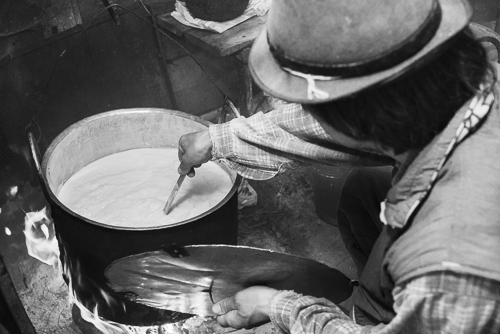Attila Sárig lives in the village where he was born together with his Hungarian wife Reka and their young son Benedec. Like all or almost all houses in the village, their property is not visible from the gravel road passing through the village because it is hidden by high fences and a big gate. The gates were probably meant for letting a horse and cart pass through, but nowadays it could also be someone’s car, which should pass through it. During my stay, it felt like there were as many horse-drawn carts as cars passing outside. The village is surrounded by hills covered by meadows full of wildflowers and deciduous forests, making it ideal for those who want rural settings in a beautiful place.
Having entered the gate, there is a small house in which the Sárig family have a combined kitchen and dining room for themselves and for their guests. There is also a small house divided in two where one part is the living quarters for the Sárig family, while the other one is the combined bedroom and bathroom for their guests.
The Sárig family slaughter their own animals and they make almost all their food themselves. Having been their guest for two days, I can attest to their delicious and genuine food – a real culinary pleasure.
Just outside their property, there is a communal garden where each family have a plot for growing vegetables and both Attila and his wife spent lots of time there tending their vegetables. Moreover, Attila’s parents have a small farm outside the village where they have six cows, 2 of their own, 2 of Attila’s family and 2 of his brother’s family. When we arrived, the cows had been let out by Attila’s parents to go grazing and they had left fresh milk from the cows in a container. Actually, the cows are milked in the morning before they are let out to go grazing, then they return in the evening when they are milked again.
Attila made a fire and put a pot with the fresh milk above it. When the milk was hot enough, about 35°C, he poured rennet on the milk and waited about 30 minutes in order to let the milk start curdling. Then, he used a knife in order to cut the cheese mass into small parts (dairies use a device called a harp to obtain the same thing) before he started stirring the cheese mass continuously. When he could gradually feel that the cheese grains were becoming more solid, he put a porous cloth into the mass, collecting the cheese grains carefully inside the cloth. He joined the corners of the cloth and lifted it up, put it in a container with an opening. through which the whey could flow and fall down in a bucket. Next, he put the cloth in a large metal ring and compressed the cheese mass in order to let the whey flow out and finally he put some weights on it in order to press out more whey.
The remaining whey was reheated and he used a utensil to collect two dishes with cheese, the cheesemaker’s soup. – a real, tasty treat. Finally, he extracted the rest of the cheese mass, which is called ricotta because it is heated twice, and poured it into a porous cloth. When everything had been extracted, he hung up the cloth with the ricotta such that the whey could escape.
Having finished making cheese, Attila used a scythe to cut some nettles which he mixed with a part of the remaining whey and gave it to a sow which lived next to the cheesemaking cottage. The rest was collected in bottles in order to give it to the pig at their house.
Attila prefers to sell his cheeses to someone he knows because there are so many rules if he sells them at markets and he has to pay for lots of paperwork.
Attila’s family also grow vegetables at the second farm, but wild animals like deer and wild boar enter the garden. They have set up an electric fence around it, but he also plans to set up a wooden fence.
Having hiked back to the village via another path, we went to a small meadow where Attila asked me to help him bring some haystacks inside a barn because it started raining. Of course, we had to do it the Romanian way, which consisted of putting two poles below the haystack before carrying it inside. The thick end of the pole had to be inserted below the haystack first and it had to be lifted occasionally in order to create some space around it, then pushed again until it passed below the whole haystack. Although the haystacks looked small, they were surprisingly heavy.
Attila and his parents have a house in the village where they want to set up an agricultural school. They want to teach everyone how to grow vegetables organically. He thought it was impossible until he went to an agricultural school in Sogn, Norway where he saw that students of all ages really wanted to learn about organic agriculture.
Attila and some locals arrange a haymaking festival every August and about 20 participants were expected at the festival this year. The guests would be housed in various places in the village and they would mow different kinds of meadows, ranging from lowland ones near the village to highland ones in the mountains.
For those who want to know more, a journalist from National Geographic has written this article.

